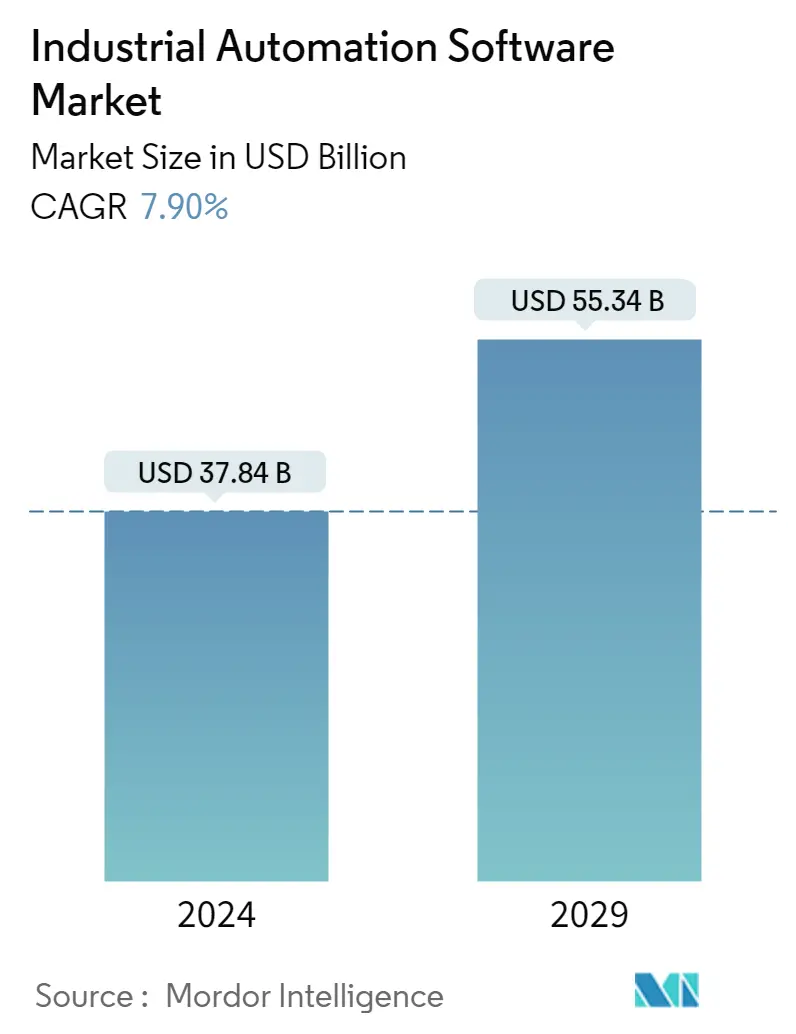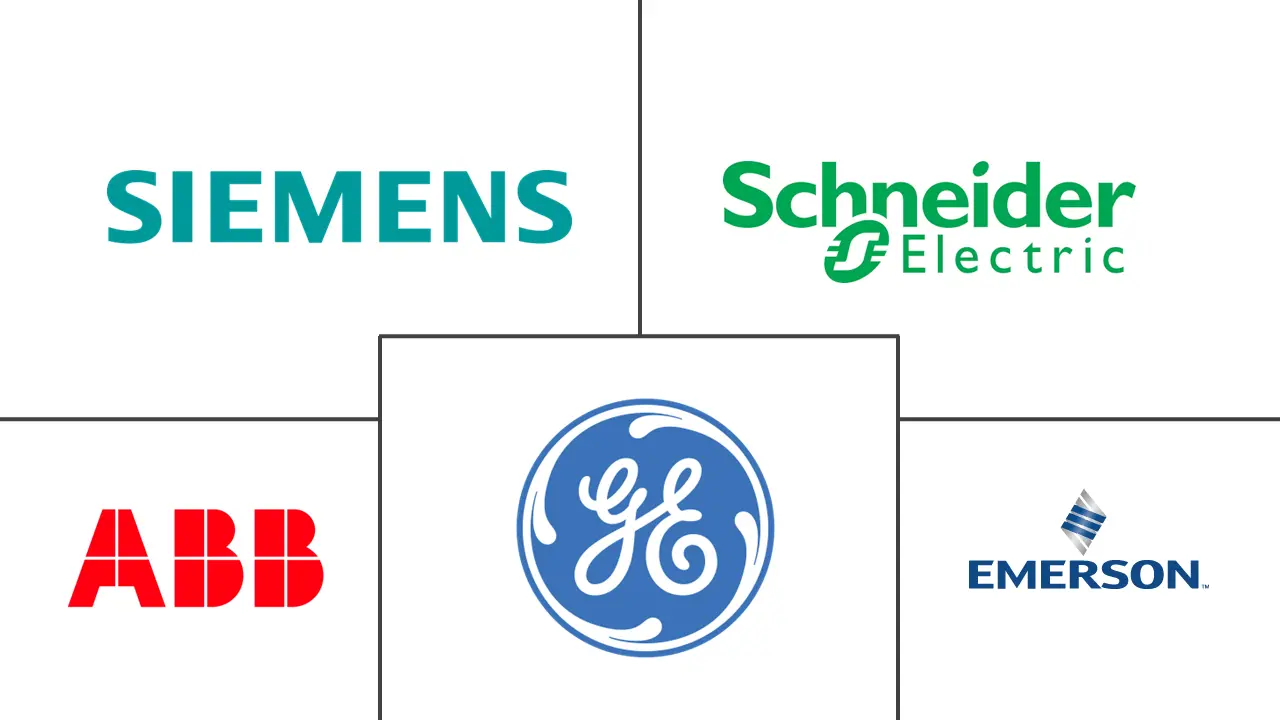Market Size of Industrial Automation Software Industry

| Study Period | 2019 - 2029 |
| Market Size (2024) | USD 37.84 Billion |
| Market Size (2029) | USD 55.34 Billion |
| CAGR (2024 - 2029) | 7.90 % |
| Fastest Growing Market | Asia Pacific |
| Largest Market | Asia Pacific |
Major Players
*Disclaimer: Major Players sorted in no particular order |
Industrial Automation Software Market Analysis
The Industrial Automation Software Market size is estimated at USD 37.84 billion in 2024, and is expected to reach USD 55.34 billion by 2029, growing at a CAGR of 7.90% during the forecast period (2024-2029).
Industrial automation software is the support system in controlling the overall industrial process. The increasing dynamic needs of various industries and complex operations and processes are driving the demand for industrial automation software. Industrial automation helps in reducing the machine hours required for operations, which can be made possible only through robust software.
- The automation of various industries has offered various benefits, such as effortless monitoring, waste reduction, and increased production speed. Automation offers customers improved quality with standardization and dependable products on time and at a much lower cost.
- Connecting industrial machinery and equipment and obtaining real-time data have played a key role in the adoption of SCADA, HMI, and PLC systems, software such as MES, APM, APC, PLM, and OTS, and control system software that offers visualization. These systems help in reducing the faults in the product, reducing downtime, scheduling maintenance, switching from a reactive state to a predictive state, and creating prescriptive stages for decision-making.
- The Industrial Internet of Things (IIoT) and Industry 4.0 are at the center of new technological approaches for the development, production, and management of the logistics chain, otherwise known as smart factory automation. These are dominating trends in the industrial sector, with machinery and devices being connected via the internet.
- However, the initial costs associated with the implementation of industrial automation solutions are high. Additionally, the costs involved in hiring and training employees who are capable of handling the solution add to the total cost, which can hinder market growth.
- The trends that existed in the pre-COVID manufacturing industry include growing adoption of Industry 4.0 throughout the world, increasing emphasis on industrial automation in manufacturing processes with increasing government support, the growing emphasis on regulatory compliance, increasing complexity and integration of supply chains, surging demand for software systems that reduce time and cost and improve overall equipment effectiveness (OEE) and the collapse of the convergence of MES and ERP layers and SCADA and MES layers. While the COVID-19 pandemic has not triggered Industry 5.0, it has brought about the adoption of Industry 4.0, which utilizes several smart manufacturing technologies. Digital workflows and automation are no longer goals; they are becoming necessary requirements. IoT devices have offered manufacturers a path toward preserving revenue streams during this pandemic.
Industrial Automation Software Industry Segmentation
Industrial automation software are used to control machinery and processes which replace human beings in performing specific functions. The technological advancements impacting the industry floor, such as in-process control and robotic equipment, are increasing, and hence, drive the demand for the industrial automation solution. The scope of the report is limited to different industrial automation solutions, such as SCADA, PLC, HMI, and their applications across the end-user industries.
| By Product | |
| Supervisory Control and Data Acquisition (SCADA) | |
| Distributed Control System (DCS) | |
| Manufacturing Execution Systems (MES) | |
| Human Machine Interface (HMI) | |
| Programmable Logic Controller (PLC) |
| By End-user Industry | |
| Power Industry | |
| Automotive Industry | |
| Oil and Gas Industry | |
| Other End-user Industries |
| By Geography | |
| North America | |
| Europe | |
| Asia Pacific | |
| Latin America | |
| Middle East and Africa |
Industrial Automation Software Market Size Summary
The Industrial Automation Software Market is poised for significant growth, driven by the increasing complexity and dynamic needs of various industries. This software acts as a crucial support system in controlling industrial processes, helping to reduce machine hours and enhance operational efficiency. The adoption of technologies such as SCADA, HMI, and PLC systems, along with software like MES, APM, and APC, is facilitating real-time data connectivity and visualization, which are essential for minimizing product faults and downtime. The integration of the Industrial Internet of Things (IIoT) and Industry 4.0 concepts is further propelling the market, as these technologies enable smart factory automation by connecting machinery and devices via the internet. Despite the high initial costs of implementation and the need for skilled personnel, the benefits of improved quality, standardization, and cost reduction are driving the demand for industrial automation software.
The market landscape is moderately competitive, with key players like Emerson, ABB, Siemens, and Schneider Electric actively expanding their global presence through strategic collaborations and acquisitions. These companies are focusing on enhancing their software offerings to improve productivity, safety, and sustainability in industrial operations. The robotics and automation sector, particularly in Germany, is witnessing rapid innovation, with advancements in human-robot collaboration and machine vision technologies. These developments are being supported by EU-based research and innovation programs aimed at maximizing digital opportunities in manufacturing. The market's growth is also reflected in the increasing adoption of smart manufacturing technologies, which have become essential for maintaining productivity and efficiency in the post-COVID-19 landscape.
Industrial Automation Software Market Size - Table of Contents
-
1. MARKET INSIGHTS
-
1.1 Market Overview
-
1.2 Industry Attractiveness - Porter's Five Forces Analysis
-
1.2.1 Bargaining Power of Suppliers
-
1.2.2 Bargaining Power of Consumers
-
1.2.3 Threat of New Entrants
-
1.2.4 Intensity of Competitive Rivalry
-
1.2.5 Threat of Substitutes
-
-
1.3 Impact of COVID-19 on the Industry
-
-
2. MARKET SEGMENTATION
-
2.1 By Product
-
2.1.1 Supervisory Control and Data Acquisition (SCADA)
-
2.1.2 Distributed Control System (DCS)
-
2.1.3 Manufacturing Execution Systems (MES)
-
2.1.4 Human Machine Interface (HMI)
-
2.1.5 Programmable Logic Controller (PLC)
-
-
2.2 By End-user Industry
-
2.2.1 Power Industry
-
2.2.2 Automotive Industry
-
2.2.3 Oil and Gas Industry
-
2.2.4 Other End-user Industries
-
-
2.3 By Geography
-
2.3.1 North America
-
2.3.2 Europe
-
2.3.3 Asia Pacific
-
2.3.4 Latin America
-
2.3.5 Middle East and Africa
-
-
Industrial Automation Software Market Size FAQs
How big is the Industrial Automation Software Market?
The Industrial Automation Software Market size is expected to reach USD 37.84 billion in 2024 and grow at a CAGR of 7.90% to reach USD 55.34 billion by 2029.
What is the current Industrial Automation Software Market size?
In 2024, the Industrial Automation Software Market size is expected to reach USD 37.84 billion.

